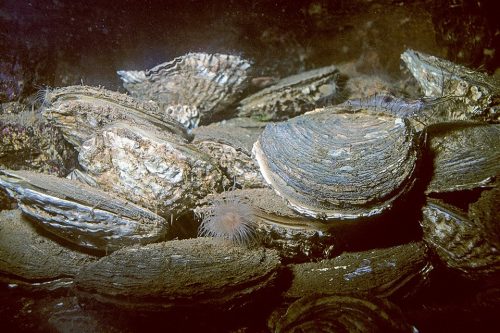“These oyster grounds consisted of reefs built of oysters, knitted and interlaced with countless other invertebrates. The bottom of the North Sea was hardened by a living crust, something that many scientists today find hard to believe”
– Professor Callum Roberts 2007, BLUE Trustee
Last week the inaugural European flat oyster restoration workshop was held in Berlin. BLUE, together with our university partners Southampton and Portsmouth joined initiatives from Scotland, Germany, Holland, Denmark, Ireland, France and Croatia to agree a European mission statement for oyster restoration.

To my delight, we were greeted by a native oyster shaped chocolate and settled down to three days of knowledge sharing and strategy building. For a European native oyster restoration workshop there could only be one starting place: Olsen’s map of the distribution of the European flat oyster (Ostrea edulis) c.1883. The map, from the Olsen’s Piscatorial Atlas, is a beautiful reminder of the historical scale and distribution oyster beds in Europe, particularly in the North Sea.

This record is part of a rich documentation of the flat, or as we know it native, oyster in Europe and its subsequent history. Exploited since the Roman times, oyster beds have followed the steep decline seen in many fisheries around the world. In Belgium, it took 300 cutters three years to decimate stocks in the 1860s and at its peak in the 19th Century the Firth of Forth fishery in Scotland had an annual yield of 50 million oysters. By 1870 oyster beds were commercially extinct in Belgium and there have been no recorded oysters in the Firth of Forth since 1957.
For the deep-sea oyster beds of the English Channel, thought to have provided larval input for areas like the Solent, another piece of historic literature highlights the volume of landings with 20,000 oysters caught per ship, every day by more than 40 ships daily between 1830 and 1876. Today, unlike most of Europe, the Solent and Essex still have small operational fisheries, but populations have been reduced to negligible levels. Ironically, the oystermen who frequently appear in these historic European records are English oystermen.
All is not lost, however, for as the day progressed we heard of restoration case studies across Europe indicating that change is coming. Joining our European gathering were three American oyster restoration pioneers: Boze Hancock and Philine Zu Ermgassen of the Nature Conservancy and Stephanie Westby of National Oceanic and Atmospheric Administration (NOAA); in the United States, as BLUE recently found out on a trip there, oyster restoration is a big deal. See BLUE’s Head of Conservation Simon Harding’s blog on the US oyster restoration trip here.

Support for those starting out in Europe exists through comprehensive handbooks covering site selection, reef design and metrics for measuring success. However, there was a real consensus that Europe must develop strategies for our own species – a very different oyster to Crassostria virginia found on the East coast of the US.

On Thursday afternoon, split into three focused workshops we discussed key considerations and current barriers to native oyster restoration in Europe with the aim of identifying actions for a European initiative. With so many areas with low or virtually extinct populations, group one; hatcheries, nurseries and ponds identified access to a reliable, affordable source of oysters with the capacity to produce the scale needed as a key action. Group two tackled monitoring, Bonamia and genetics and called for restoration initiatives to work with industry to develop and share best-practice including; strict import protocols for transport of oysters, case studies using Bonamia free or tolerant oysters and work to define Bonamia tolerance.
I had joined group three: sites/areas, substrate and reef design where it was recognised that lessons from the United States and best-practice in Europe must be applicable and will have to be adaptable as so many initiatives grapple with local conditions: nature designations, competition for space, fisheries and, perhaps most importantly, licence and consent protocol. I can imagine the look of horror on government agency faces in the Solent if I turned up with 3000,000 cubic yards of rock and other reef building material – the amount used to create substrate in Harris Creek, Chesapeake Bay. Perhaps this last point resonated the most as we made our declaration on the final day to work together to restore the native oyster to Europe – that long-term success in restoring the native oyster in Europe needs support from policy makers to encourage creativity around approaches to restoration.

Flying back over the North Sea, eating my chocolate oyster, I imagined the vast biogenic reefs, silent engineers of the North Sea hidden in the dark captured by Olsen in 1883. I felt a real sense of excitement that our efforts in the Solent and others linked by this sea are making the first steps in Europe to restore our native.
Check out our other blogs for updates on BLUE’s Solent Oyster Restoration Project:


















